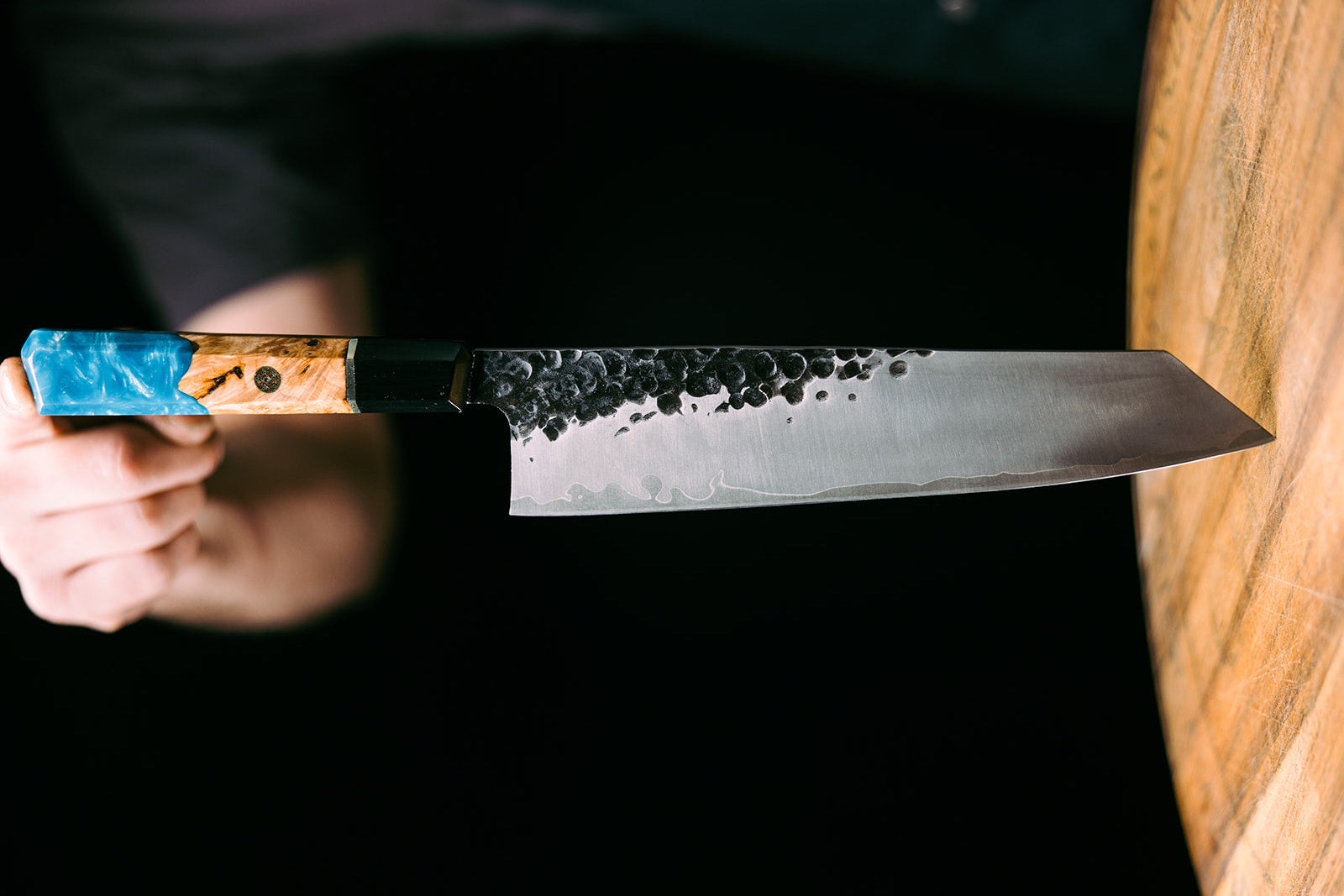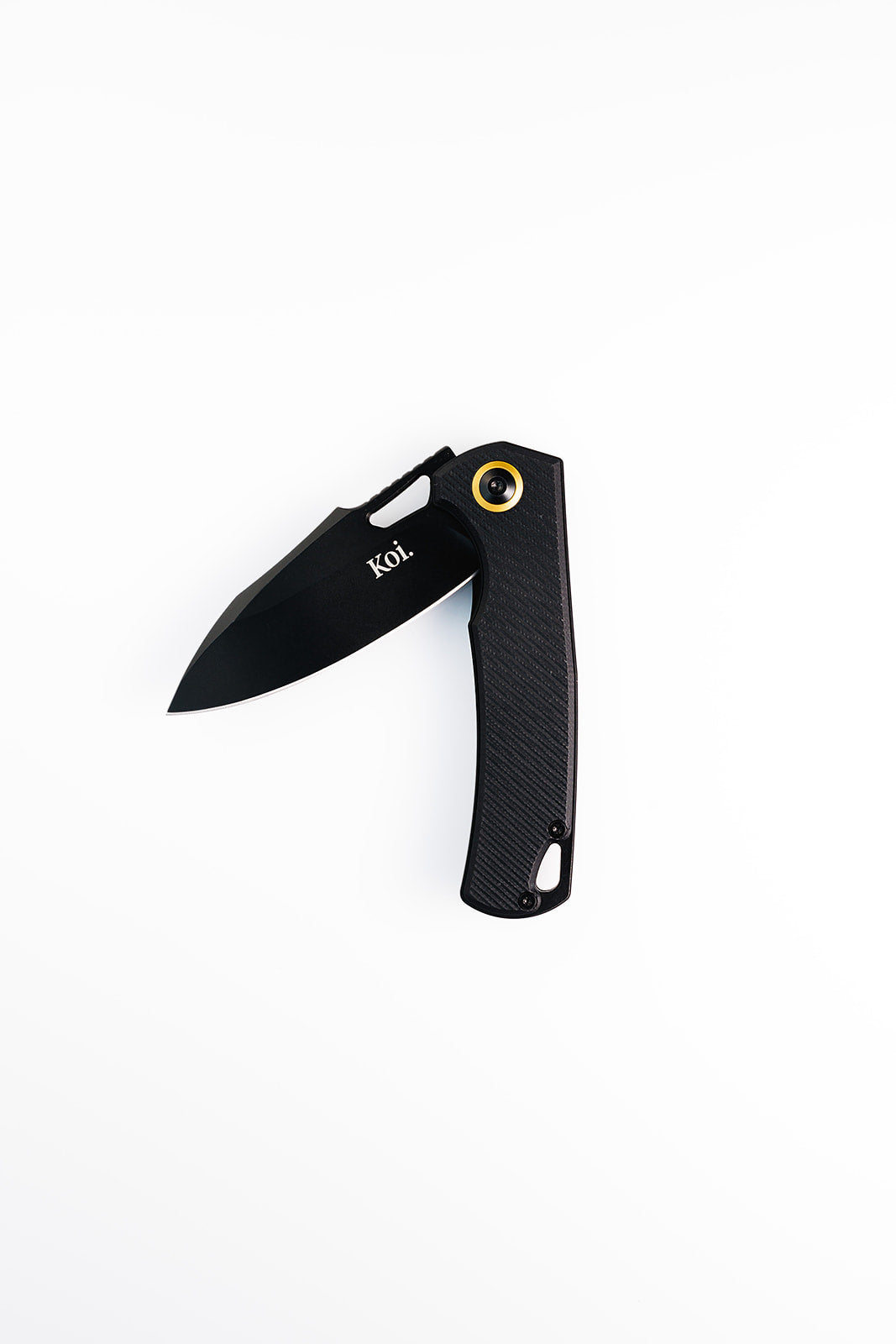Click here to see the different blade finishes we're working with
The Different Blade Finishes for Japanese Knives
You will notice that the surfaces of the Japanese kitchen knives look quite different. Unless you have a particular preference for knives that look a certain way, you are most likely going to purchase Japanese knives with a large variance of finishes. That is not accidental. The Japanese knifemaking tradition has spurned out different kinds of finishes over the centuries ranging from the forge finishes to hammer finishes, polished finishes, and unpolished finishes. What do these finishes entail and how do they pan out in the final knife product? Which one should you go for?
In this article, we look at some of the five main types of finishes used in Japanese knives, including kitchen knives. It is important to note that the differences in these finishes are only aesthetic and have no bearing on the performance of the knives. Some chefs will, of course, insist that certain kinds of finishes give better performance or allow food to easily brush off the blade more than others. However, this is purely subjective. The knife technique will have a greater bearing on the performance of the kitchen knife than its aesthetic finishes. However, the knife aesthetic can have an emotional impact. If you cook with beautiful cutlery, you are likely to develop some connection with them and you will love doing your job. Some people develop a strong passion for cooking out of the quality of cutlery and equipment that they use in the process. That could certainly have some bearing on your cooking performance!
The five main types of finishes used in Japanese kitchen knives that we are going to look at include: -
- Kurouchi / Blacksmith
- Nashiji / Pear
- Migaki / Polished
- Damascus / Damascus
- Tsuchime / Hand-hammered
Some finishes such as Kurouchi are more rustic and less polished while others like the Migaki are more polished and less rustic. As we shall see, each of these has its benefits and weaknesses.
Kurouchi / Blacksmith

A Kurouchi-finished knife looks almost unfinished. It’s like the blacksmith simply got tired and forgot to apply the last finishes after forging the knife. It is also referred to as ‘blacksmith’s finish’. In Japanese, ‘kurouchi’ means ‘first black’.
The Kurouchi finish is the least refined of these Japanese kitchen knife finishes. It is a traditional and rustic finish where the knife will retain the black scaly residue from the forging process. Because it is not refined, the black forged patina of the Kurouchi finish is very low cost and drastically cuts down on the cost of production. These knives, therefore, tend to be cheaper. It also confers certain properties to the knife. For example, it will minimize the reactivity of a carbon steel knife and the final knife piece will be characterful; it will have a certain rustic charm and aesthetic that appeals highly to a certain kind of chef and discerning knife enthusiasts in general.
Because the Kurouchi is a blacksmith’s finish that is a product of different forges, there is also great variance in their appearance, uniformity, and resilience, another aspect that adds to the characterful quality of the Kurouchi knives. When you look at the knives closely, you will not fail to admire the complex organic look and feel of the blacksmith’s finish. They really look unique and no two knives will have the exact finishes. Besides, the Kurouchi knife will continue developing a character or patina over several years of use thereby increasing their unique quality and chefs can really fall in love with this. It becomes really their knife.
On the flip side, the blacksmith’s finish has degrees of resilience and some will wear off more easily than others, particularly if you clean them with an abrasive material. To retain this finish for much longer, it is advisable to clean them using a non-abrasive washing material.
Nashiji /Pear

Nashiji in Japanese means ‘pear skin pattern’. It has a cool-textured feel that comes from a knife finishing technique where the surface of the blade is left looking unfinished or rustic. The finish imitates the skin of the Asian pear. The Nashiji finish is different from the Kurouchi in the way that it is lightly dappled which gives it a smoother finish than Kurouchi. However, the Nashiji finish is still coarser than a satin finish. They provide a little texturing on the knife that is very pleasant to hold. They also have very striking looks. The Nashiji finish is somewhere in the middle between the Kurouchi and the finely polished Migaki. They are also very affordable.
Migaki / Polished

Migaki is the polished finish on the Japanese knives. However, it is not as finely polished like a mirror finish. Besides, there will be some variance in the degree of the polishing from one bladesmith to the next. The degree of the reflectiveness in the MIgaki knives will therefore vary from manufacturer to manufacturer. Some manufacturers achieve an almost mirror-like polish while others do a cloudy polished finish. Polished Japanese knives look quite elegant but there are some disadvantages with having a finely polished knife. The more polished the knife, the more conspicuous the scratches on the knife will be and this will ultimately ruin their aesthetic appeal. The textured finishes such as Damascus, Nashiji, and Kurouchi are much better at hiding scratches and are therefore more likely to retain a constant aesthetic over extended usage.
Tsuchime / Hand-Hammered

A Tsuchime finish refers to a hand-hammered finish. You are unlikely to attain any semblance of uniformity from hand-hammering steel so these finishes have the largest variances in the finishing textures. The textured finish will vary from make to make and even within the same make! Tsuchime entails hammering the knife up the forging process and even incorporating some marks and dimples in the pattern. Blacksmiths use different hammerheads to create the Tsuchime finish and to etch cool patterns on the knives, they might even vary the frequency of applying the hammering marks. The final product is really beautiful and is the ultimate expression of individualism and truly organic design.
Damascus / Damascus

Originating in the Middle Eastern city of the same name in antiquity, Damascus steel finishes are as old as ironworking itself. Blades etched with Damascus patterns are loved for their stunning water-like patterning as well as their sharpness.
For centuries, Damascus etching methods were a closely guarded secret and the true formula disappeared for good somewhere in the 18th century. But it entailed the use of various blade-folding techniques with some of the unique steel impurities adding to its awesome pattern.
Modern-day Damascus patterned steel knives utilize different steel grades that are repeatedly folded together, usually around a pure knife-grade steel core. After the layering, they are heated together, hammered out, and welded together and the process repeated as the number of layers continues to grow exponentially. The result is the distinctive patterning forged from layers of steel which looks really unique and beautiful. Damascus steel knives are generally slightly more expensive due to the elaborate forging process involved in making them. These knives are also typically very sharp and durable. They try to closely imitate the appearance of the Damascus steel knives of yore and they do it with some degree of success. The Damascus steel patterned knives look so cool you would want to use them all the time!
These are some of the main finishes used in Japanese kitchen knives. Which others do you know? Share with us in the comment section.



